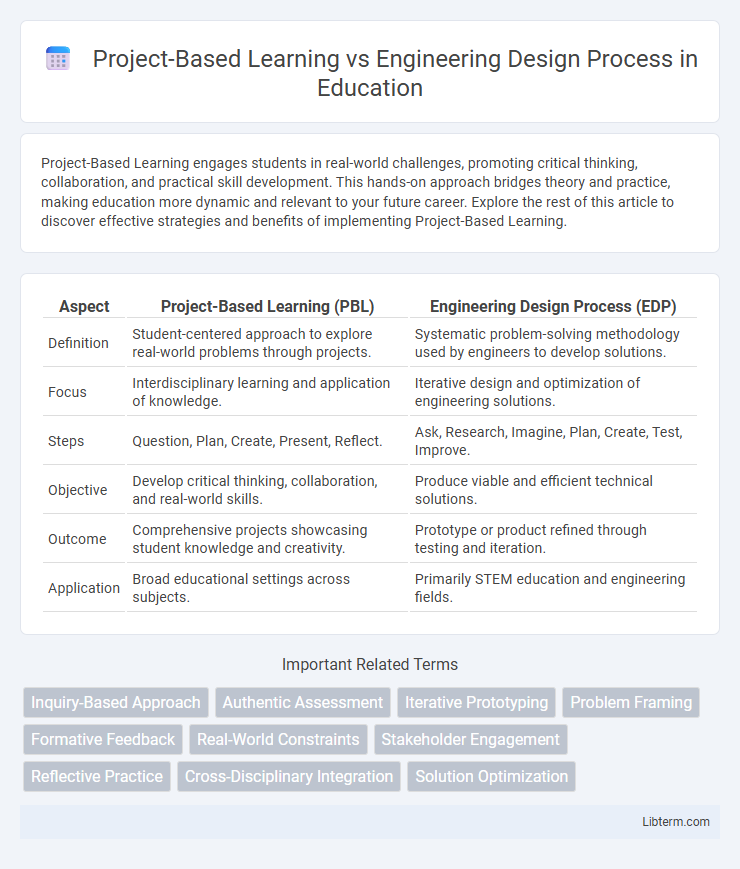Project-Based Learning engages students in real-world challenges, promoting critical thinking, collaboration, and practical skill development. This hands-on approach bridges theory and practice, making education more dynamic and relevant to your future career. Explore the rest of this article to discover effective strategies and benefits of implementing Project-Based Learning.
Table of Comparison
| Aspect | Project-Based Learning (PBL) | Engineering Design Process (EDP) |
|---|---|---|
| Definition | Student-centered approach to explore real-world problems through projects. | Systematic problem-solving methodology used by engineers to develop solutions. |
| Focus | Interdisciplinary learning and application of knowledge. | Iterative design and optimization of engineering solutions. |
| Steps | Question, Plan, Create, Present, Reflect. | Ask, Research, Imagine, Plan, Create, Test, Improve. |
| Objective | Develop critical thinking, collaboration, and real-world skills. | Produce viable and efficient technical solutions. |
| Outcome | Comprehensive projects showcasing student knowledge and creativity. | Prototype or product refined through testing and iteration. |
| Application | Broad educational settings across subjects. | Primarily STEM education and engineering fields. |
Understanding Project-Based Learning
Project-Based Learning (PBL) emphasizes student-centered inquiry where learners engage in real-world challenges to develop critical thinking, collaboration, and problem-solving skills through prolonged projects. Unlike the structured Engineering Design Process (EDP) which follows defined stages such as problem identification, ideation, prototyping, and testing, PBL allows more flexibility in exploration and integration of interdisciplinary knowledge. Effective PBL environments foster creativity and autonomy, encouraging students to take ownership of their learning while applying academic concepts to authentic contexts.
Defining the Engineering Design Process
Defining the Engineering Design Process involves a systematic series of steps including identifying the problem, researching, brainstorming solutions, prototyping, testing, and refining. Unlike Project-Based Learning, which emphasizes student-driven exploration and broad project goals, the Engineering Design Process centers on iterative problem-solving and technical precision. This method ensures that solutions are optimized through repeated analysis and modification based on empirical data and user feedback.
Core Principles of Project-Based Learning
Project-Based Learning (PBL) centers on student-driven inquiry, real-world problem solving, and collaborative teamwork, fostering critical thinking and deep understanding. Unlike the Engineering Design Process, which emphasizes iterative prototyping and optimization specifically in engineering contexts, PBL integrates interdisciplinary knowledge and authentic assessment through sustained projects. Core principles of PBL include meaningful student voice and choice, inquiry-based investigations, and reflection to enhance learning and skill development.
Key Stages in the Engineering Design Process
The Engineering Design Process consists of key stages including defining the problem, conducting background research, specifying requirements, brainstorming solutions, choosing the best solution, developing prototypes, testing and evaluating, and iterating improvements. Each stage emphasizes systematic problem-solving, critical thinking, and refinement to create functional and efficient designs. Project-Based Learning integrates these stages by engaging students in real-world projects that require applying the engineering design steps to achieve tangible outcomes.
Educational Goals: PBL vs Engineering Design
Project-Based Learning (PBL) emphasizes interdisciplinary knowledge application and student-driven exploration to enhance critical thinking, collaboration, and real-world problem-solving skills. The Engineering Design Process centers on iterative problem-solving and technical skill development to optimize solutions within engineering constraints. While PBL targets broader educational goals such as creativity and communication, the Engineering Design Process specifically aims to build structured analytical reasoning and technical proficiency.
Student Engagement in Each Approach
Project-Based Learning (PBL) actively engages students by immersing them in real-world challenges that require critical thinking and collaboration, fostering intrinsic motivation through ownership of the learning process. The Engineering Design Process (EDP) emphasizes iterative problem-solving and hands-on experimentation, which promotes sustained student engagement by encouraging creativity and resilience in refining solutions. Both approaches enhance engagement by situating learning in authentic contexts, but PBL often broadens engagement across interdisciplinary skills while EDP focuses intensively on engineering-specific competencies.
Assessment Strategies: Comparing PBL and EDP
Assessment strategies in Project-Based Learning (PBL) emphasize authentic, formative evaluations such as student reflections, peer reviews, and real-world project outcomes to gauge understanding and skill application. In contrast, the Engineering Design Process (EDP) assessments focus on iterative progress checkpoints, prototype testing results, and adherence to engineering criteria to measure problem-solving effectiveness and technical competency. Both approaches prioritize evidence of practical skills, but PBL leans more on holistic evaluation, while EDP centers on technical precision and iterative improvement documentation.
Real-World Application and Industry Relevance
Project-Based Learning (PBL) emphasizes student-driven exploration and problem-solving connected to real-world challenges, fostering critical thinking and collaboration skills essential in professional settings. The Engineering Design Process (EDP) offers a structured, iterative framework for innovation, closely aligning with industry standards for product development and technical problem resolution. Both methodologies enhance industry relevance by bridging theoretical knowledge with practical application, preparing learners for dynamic engineering roles.
Challenges and Limitations of Both Methods
Project-Based Learning (PBL) often faces challenges in maintaining student engagement and ensuring equitable assessment due to its open-ended nature and reliance on collaboration. The Engineering Design Process (EDP) encounters limitations in flexibility, as its structured stages can constrain creativity and adaptability in real-world problem-solving. Both methods require significant time investment and resources, which can impede implementation in diverse educational settings with limited support.
Choosing the Right Approach for Your Classroom
Project-Based Learning emphasizes student-driven inquiry and real-world problem solving, fostering critical thinking and collaboration skills. The Engineering Design Process offers a structured framework with defined stages like brainstorming, prototyping, and testing, ideal for teaching systematic problem-solving skills in STEM education. Selecting the right approach depends on your classroom goals: PBL suits open-ended exploration and interdisciplinary projects, while the Engineering Design Process targets skill development in technical design and iterative improvement.
Project-Based Learning Infographic

 libterm.com
libterm.com